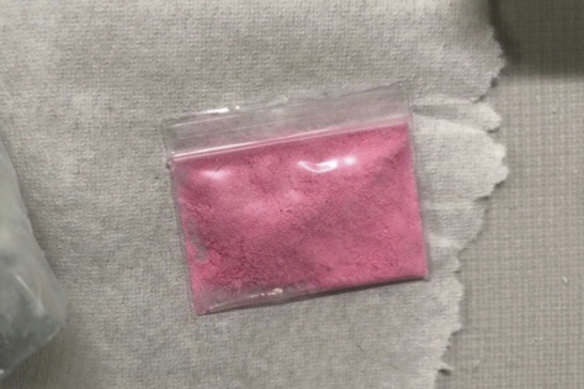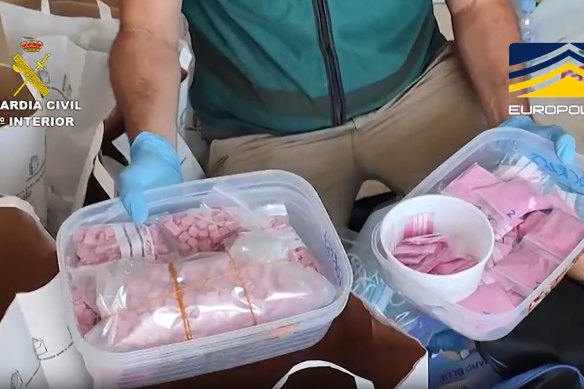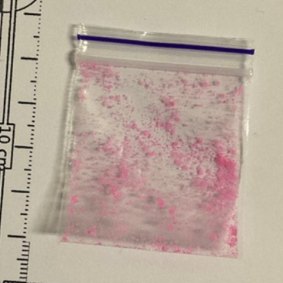By Jessica McSweeney and Perry Duffin
Pink cocaine – it’s a brightly coloured, highly dangerous and (sometimes) strawberry tasting party drug that’s been linked to recently deceased singer Liam Payne and disgraced rapper Sean “Diddy” Combs.
Associates of Diddy, who faces multiple sexual assault lawsuits in the US, said pink cocaine was the musician’s drug of choice. The drug was also found in the system of former One Direction singer Payne, who fell to his death in Argentina last week.

This photo provided by the Office of the Special Narcotics Prosecutor in New York shows a bag of pink cocaine in January 2023.Credit: AP
It’s a dangerous drug that is worrying doctors and police across the globe – especially in party precincts of Spain, South America, and Miami – but it’s also been detected in Australia.
Here’s everything you need to know.
What is pink cocaine?
Despite its name, there’s usually little to no actual cocaine in pink cocaine. Also known as “tusi”, pink cocaine is actually a cocktail of other drugs including MDMA, ketamine and 2C-B (a synthetic psychedelic drug).
It’s usually sold as bright-pink powder or pills that sometimes taste of strawberry, getting its colour from food dye.
The drug became popular in Colombia before spreading throughout South America’s party scene. The drug spread to Spain where it became a popular drug in party strips in Ibiza and Malaga. It has since spread throughout Europe.
ITV News reported last month that Spanish authorities had seized their largest haul yet of pink cocaine at 21kg.
Why is it in the news?
The hearts of One Direction fans were broken when Liam Payne fell to his death from his Buenos Aires hotel room balcony last week.
A toxicology report found the 31-year-old had multiple drugs in his system, including pink cocaine. Police also found evidence of drugs and drug paraphernalia inside the hotel room.

Liam Payne.Credit: Getty Images
Hotel staff had called the police in the moments before Payne’s death: “We have a guest who is intoxicated with drugs and alcohol,” an audio recording of the call said in Spanish. “And well, when he’s conscious, he’s breaking everything in the room. We need someone to be sent, please.”
Pink cocaine is also a go-to party drug for disgraced rapper Sean “Diddy” Combs, a complainant against him alleges. People magazine reported the rapper would require all his employees to carry the drug with them, according to a statement from Rodney “Lil Rod” Jones, who accuses the entertainer of sexual harassment.
What are the dangers?
Pink cocaine is particularly dangerous because it’s a Russian roulette drug – users never really know what they’re getting. Partygoers who buy the drug have no way of knowing which combination of stimulants and psychedelics they are taking, making it easy to overdose.
While ketamine, MDMA and 2C-B are the most common ingredients, it can also contain fentanyl, a synthetic opioid prescribed for severe cancer pain that has been linked to 833 deaths in Australia between 2001 and 2021.
A high proportion of ketamine can also lead to intense anxiety and panic, and can lead users to completely disassociate from reality, making them more vulnerable to accidents. Friends star Matthew Perry was prescribed ketamine to treat depression, however, prosecutors said he went on to obtain higher doses of the drug illegally.
Perry overdosed on ketamine after being injected with it multiple times on the day of his death.
Is it in Australia?
Drug experts say pink cocaine, or tusi, is yet to be detected in NSW but warn it has turned up at pill testing sites in both Canberra and Brisbane – and could be cut with ultra-potent and potentially fatal opioids.

Pink cocaine seized by Spanish military police during a raid.Credit: Guardia Civil
“Tusi is not something we are seeing come up more broadly, and no public health alerts have gone out in Australia,” National Centre for Clinical Research on Emerging Drugs chief Krista Siefried told this masthead.
“However, two community alerts were shared by drug testing sites in Queensland and the ACT.”

Pink cocaine found in Canberra by a drug testing facility. Credit: Cantest
The latest came after two people walked into Brisbane’s testing lab, CheQpoint, with a powder they expected to be 2C-B, a psychedelic also known as Nexus in June. CheQpoint found ketamine, caffeine and MDMA but no 2C-B.
CanTest, Canberra’s pill testing service, made a similar detection in May 2023; saying they found ketamine, MDMA and cocaine in a powder falsely sold to users as 2C-B.
Siefried said the detections showed the usefulness of drug testing services and warned tusi had been known to contain opioids.
That poses an increased risk given the rise of nitazenes, ultra strong synthetic opioids which have been behind a rise in fatal overdoses in Australia.
“Given the rise in nitazenes detections in Australia, there would be a risk of tusi being adulterated with these strong opioids,” Siefried said.“It’s important that people are aware of naloxone, a medication that can reverse an opioid overdose, as these can be present in a polydrug formulation such as tusi.”
Start the day with a summary of the day’s most important and interesting stories, analysis and insights. Sign up for our Morning Edition newsletter.